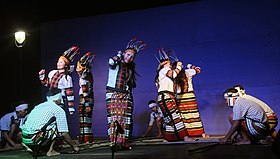
Back Mizoram ACE Mizoram ANG मिज़ोरम ANP ميزورام Arabic মিজোৰাম Assamese Mizorán AST Mizoram Azerbaijani میزورام AZB Mizoram BAN Mizoram BCL
Mizoram (English: /mɪˈzɔːrəm/ ⓘ) is a landlocked state in northeast India, with Aizawl as its seat of government and largest city. Within India's northeast region, it is the southernmost state, sharing borders with three of the Seven Sister States, namely Tripura, Assam and Manipur, and also shares a 722-kilometre (449 mi) border with the neighbouring countries of Bangladesh and Myanmar.[5] The state spans over an area of approximately 21,087 square kilometres,[6] of which approximately 91% is forested.[7] With an estimated population of 1.25 million in 2023, it is the second least populous state in the country.[8]
Like several other northeastern states of India, Mizoram was previously part of Assam until 1972, when it was carved out as a Union Territory. In 1986, the Indian Parliament adopted the 53rd amendment of the Indian Constitution, which allowed for the creation of the State of Mizoram on 20 February 1987, as India's 23rd state.
About 95% of Mizoram's population descends from a diverse tribal origin. Mizos first began to settle the area in the 16th century, coming in waves of immigration from Southeast Asia. This immigration lasted through the 18th century.[9] Among all of the states of India, Mizoram has the highest concentration of tribal people. The Mizoram people are currently protected under the Indian constitution as a Scheduled Tribe.[10] Mizoram is one of three states of India with a Christian majority (87%).[11]
Mizoram is a highly literate agrarian economy. Slash-and-burn farming, also known as jhum, is the most common form of farming in the state.[12] In recent years, the jhum farming practices have been steadily replaced with a significant horticulture and bamboo products industry.[13][14] The state's gross state domestic product for 2012 was estimated at ₹69.91 billion (US$880 million).[6] About 20% of Mizoram's population lives below the poverty line, with 35% rural poverty as of 2014.[15] The state has about 871 kilometres of national highways, with NH–54 and NH–150 connecting it to Assam and Manipur respectively. It is also a growing transit point for trade with Myanmar and Bangladesh.[16]
- ^ "AREA AND POPULATION - Statistical Year Book India 2017 | Ministry of Statistics and Program Implementation | Government Of India". www.mospi.gov.in. Archived from the original on 4 August 2020. Retrieved 9 February 2020.
- ^ "Ministry of Development of North Eastern Region, North East India". mdoner.gov.in. Archived from the original on 26 January 2021. Retrieved 24 February 2021.
- ^ "Sub-national HDI – Area Database". Global Data Lab. Institute for Management Research, Radboud University. Archived from the original on 23 September 2018. Retrieved 25 September 2018.
- ^ Cite error: The named reference
Literacywas invoked but never defined (see the help page). - ^ "About Mizoram". Directorate Of Information & Public Relations, Government of Mizoram. Archived from the original on 20 June 2014. Retrieved 30 October 2023.
- ^ a b Cite error: The named reference
ppimizowas invoked but never defined (see the help page). - ^ Cite error: The named reference
fsi11was invoked but never defined (see the help page). - ^ "Indian states 2023 population estimates". www.main.mohfw.gov.in. 1 December 2023. Retrieved 29 March 2024.
- ^ J.M. Lloyd, History of the Church in Mizoram: Harvest in the Hills (Aizawl: Synod publication Board, 1991, 2), OCLC 29798339.
- ^ Cite error: The named reference
tribalmizowas invoked but never defined (see the help page). - ^ "Mizoram", Population by religious communities, IN: Census, 2001, archived from the original on 1 July 2010, retrieved 11 October 2013.
- ^ Cite error: The named reference
sapagriwas invoked but never defined (see the help page). - ^ Cite error: The named reference
agristatwas invoked but never defined (see the help page). - ^ Cite error: The named reference
ibef2was invoked but never defined (see the help page). - ^ Cite error: The named reference
rbipovwas invoked but never defined (see the help page). - ^ Cite error: The named reference
ibefwas invoked but never defined (see the help page).
© MMXXIII Rich X Search. We shall prevail. All rights reserved. Rich X Search







